Afghan vs Czechoslovakian Community Comparison
COMPARE
Afghan
Czechoslovakian
Social Comparison
Social Comparison
Afghans
Czechoslovakians
7,658
SOCIAL INDEX
74.1/ 100
SOCIAL RATING
108th/ 347
SOCIAL RANK
7,027
SOCIAL INDEX
67.8/ 100
SOCIAL RATING
132nd/ 347
SOCIAL RANK
Czechoslovakian Integration in Afghan Communities
The statistical analysis conducted on geographies consisting of 126,808,806 people shows a weak positive correlation between the proportion of Czechoslovakians within Afghan communities in the United States with a correlation coefficient (R) of 0.230. On average, for every 1% (one percent) increase in Afghans within a typical geography, there is an increase of 0.009% in Czechoslovakians. To illustrate, in a geography comprising of 100,000 individuals, a rise of 1,000 Afghans corresponds to an increase of 9.2 Czechoslovakians.
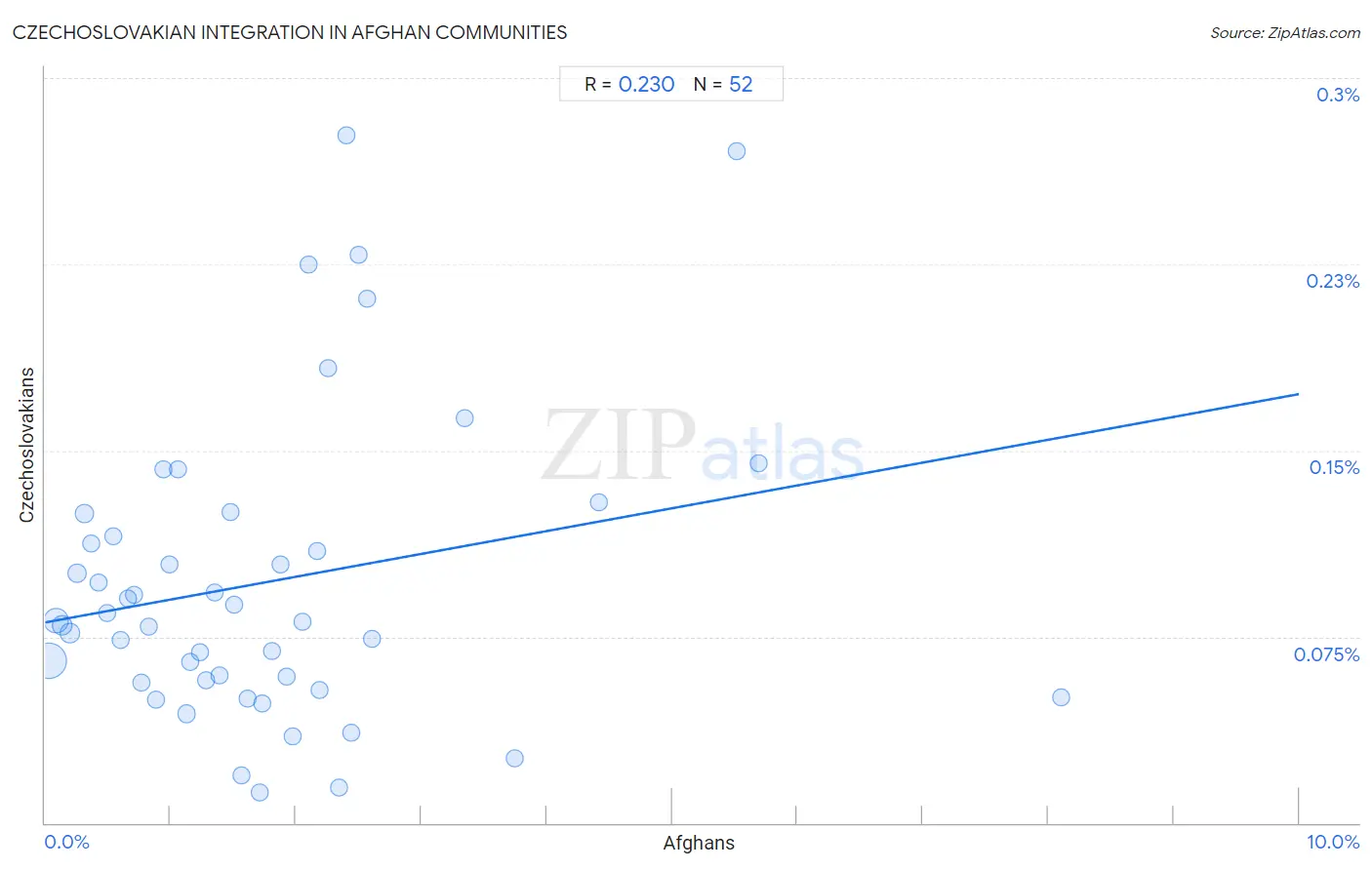
Afghan vs Czechoslovakian Income
When considering income, the most significant differences between Afghan and Czechoslovakian communities in the United States are seen in median household income ($97,026 compared to $84,965, a difference of 14.2%), householder income over 65 years ($68,951 compared to $60,581, a difference of 13.8%), and householder income under 25 years ($58,019 compared to $51,224, a difference of 13.3%). Conversely, both communities are more comparable in terms of per capita income ($46,268 compared to $43,806, a difference of 5.6%), median male earnings ($59,554 compared to $55,382, a difference of 7.5%), and median family income ($112,971 compared to $103,273, a difference of 9.4%).

| Income Metric | Afghan | Czechoslovakian |
| Per Capita Income | Exceptional $46,268 | Average $43,806 |
| Median Family Income | Exceptional $112,971 | Average $103,273 |
| Median Household Income | Exceptional $97,026 | Average $84,965 |
| Median Earnings | Exceptional $51,112 | Average $46,658 |
| Median Male Earnings | Exceptional $59,554 | Good $55,382 |
| Median Female Earnings | Exceptional $43,077 | Poor $38,738 |
| Householder Age | Under 25 years | Exceptional $58,019 | Tragic $51,224 |
| Householder Age | 25 - 44 years | Exceptional $104,410 | Average $95,070 |
| Householder Age | 45 - 64 years | Exceptional $112,676 | Good $101,387 |
| Householder Age | Over 65 years | Exceptional $68,951 | Average $60,581 |
| Wage/Income Gap | Excellent 24.9% | Tragic 28.2% |
Afghan vs Czechoslovakian Poverty
When considering poverty, the most significant differences between Afghan and Czechoslovakian communities in the United States are seen in married-couple family poverty (5.5% compared to 4.4%, a difference of 27.2%), single male poverty (10.7% compared to 13.4%, a difference of 25.0%), and single father poverty (14.0% compared to 17.1%, a difference of 22.3%). Conversely, both communities are more comparable in terms of child poverty under the age of 5 (16.8% compared to 16.8%, a difference of 0.26%), seniors poverty over the age of 75 (11.2% compared to 10.9%, a difference of 2.7%), and seniors poverty over the age of 65 (9.8% compared to 9.5%, a difference of 3.4%).
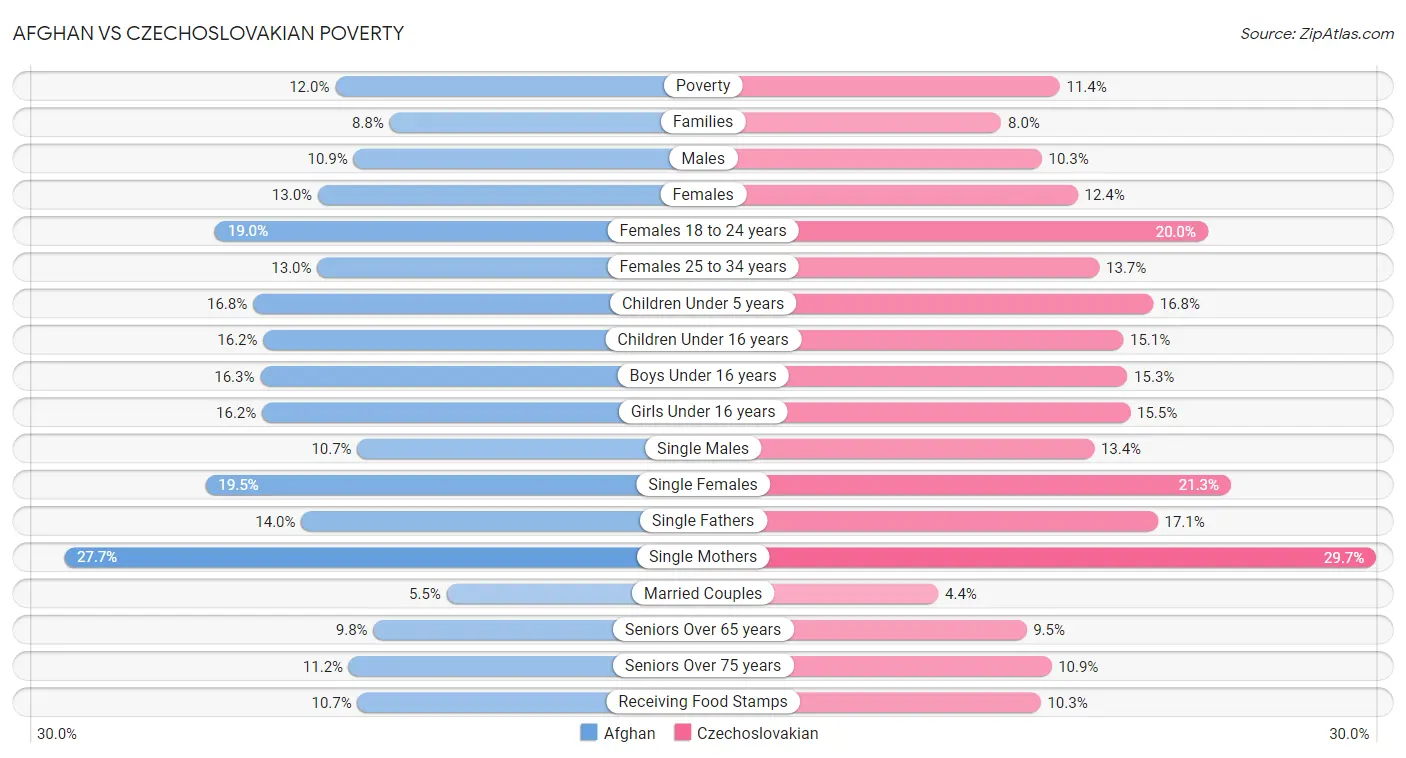
| Poverty Metric | Afghan | Czechoslovakian |
| Poverty | Good 12.0% | Exceptional 11.4% |
| Families | Good 8.8% | Exceptional 8.0% |
| Males | Good 10.9% | Exceptional 10.3% |
| Females | Good 13.0% | Exceptional 12.4% |
| Females 18 to 24 years | Exceptional 19.0% | Good 20.0% |
| Females 25 to 34 years | Excellent 13.0% | Fair 13.7% |
| Children Under 5 years | Good 16.8% | Good 16.8% |
| Children Under 16 years | Average 16.2% | Exceptional 15.1% |
| Boys Under 16 years | Average 16.3% | Exceptional 15.3% |
| Girls Under 16 years | Good 16.2% | Excellent 15.5% |
| Single Males | Exceptional 10.7% | Tragic 13.4% |
| Single Females | Exceptional 19.5% | Fair 21.3% |
| Single Fathers | Exceptional 14.0% | Tragic 17.1% |
| Single Mothers | Exceptional 27.7% | Poor 29.7% |
| Married Couples | Poor 5.5% | Exceptional 4.4% |
| Seniors Over 65 years | Exceptional 9.8% | Exceptional 9.5% |
| Seniors Over 75 years | Exceptional 11.2% | Exceptional 10.9% |
| Receiving Food Stamps | Exceptional 10.7% | Exceptional 10.3% |
Afghan vs Czechoslovakian Unemployment
When considering unemployment, the most significant differences between Afghan and Czechoslovakian communities in the United States are seen in unemployment among women with children ages 6 to 17 years (7.6% compared to 9.1%, a difference of 20.1%), female unemployment (5.3% compared to 4.8%, a difference of 10.9%), and unemployment among women with children under 6 years (7.0% compared to 7.7%, a difference of 10.2%). Conversely, both communities are more comparable in terms of unemployment among seniors over 65 years (5.0% compared to 5.0%, a difference of 0.27%), unemployment among ages 30 to 34 years (5.5% compared to 5.4%, a difference of 1.0%), and unemployment among ages 65 to 74 years (5.2% compared to 5.3%, a difference of 2.2%).
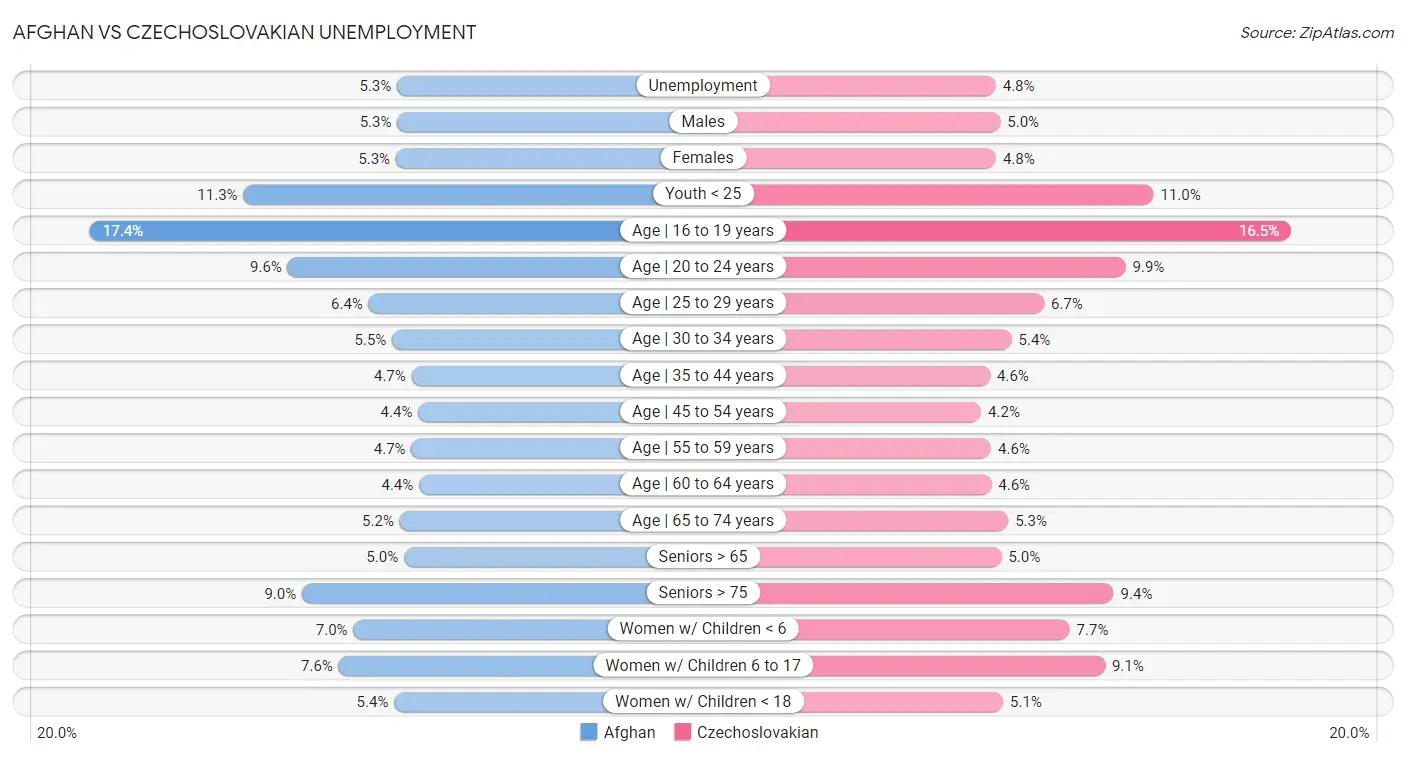
| Unemployment Metric | Afghan | Czechoslovakian |
| Unemployment | Average 5.3% | Exceptional 4.8% |
| Males | Good 5.3% | Exceptional 5.0% |
| Females | Fair 5.3% | Exceptional 4.8% |
| Youth < 25 | Excellent 11.3% | Exceptional 11.0% |
| Age | 16 to 19 years | Good 17.4% | Exceptional 16.5% |
| Age | 20 to 24 years | Exceptional 9.6% | Exceptional 9.9% |
| Age | 25 to 29 years | Exceptional 6.4% | Average 6.7% |
| Age | 30 to 34 years | Average 5.5% | Good 5.4% |
| Age | 35 to 44 years | Average 4.7% | Excellent 4.6% |
| Age | 45 to 54 years | Excellent 4.4% | Exceptional 4.2% |
| Age | 55 to 59 years | Exceptional 4.7% | Exceptional 4.6% |
| Age | 60 to 64 years | Exceptional 4.4% | Exceptional 4.6% |
| Age | 65 to 74 years | Exceptional 5.2% | Excellent 5.3% |
| Seniors > 65 | Exceptional 5.0% | Exceptional 5.0% |
| Seniors > 75 | Tragic 9.0% | Tragic 9.4% |
| Women w/ Children < 6 | Exceptional 7.0% | Fair 7.7% |
| Women w/ Children 6 to 17 | Exceptional 7.6% | Fair 9.1% |
| Women w/ Children < 18 | Good 5.4% | Exceptional 5.1% |
Afghan vs Czechoslovakian Labor Participation
When considering labor participation, the most significant differences between Afghan and Czechoslovakian communities in the United States are seen in in labor force | age 16-19 (36.1% compared to 41.9%, a difference of 16.1%), in labor force | age > 16 (67.1% compared to 64.3%, a difference of 4.3%), and in labor force | age 20-24 (75.2% compared to 77.5%, a difference of 3.0%). Conversely, both communities are more comparable in terms of in labor force | age 35-44 (84.6% compared to 84.6%, a difference of 0.040%), in labor force | age 30-34 (84.7% compared to 84.8%, a difference of 0.060%), and in labor force | age 45-54 (83.5% compared to 83.0%, a difference of 0.60%).

| Labor Participation Metric | Afghan | Czechoslovakian |
| In Labor Force | Age > 16 | Exceptional 67.1% | Tragic 64.3% |
| In Labor Force | Age 20-64 | Exceptional 80.3% | Average 79.5% |
| In Labor Force | Age 16-19 | Fair 36.1% | Exceptional 41.9% |
| In Labor Force | Age 20-24 | Good 75.2% | Exceptional 77.5% |
| In Labor Force | Age 25-29 | Poor 84.4% | Exceptional 85.0% |
| In Labor Force | Age 30-34 | Average 84.7% | Good 84.8% |
| In Labor Force | Age 35-44 | Excellent 84.6% | Excellent 84.6% |
| In Labor Force | Age 45-54 | Exceptional 83.5% | Good 83.0% |
Afghan vs Czechoslovakian Family Structure
When considering family structure, the most significant differences between Afghan and Czechoslovakian communities in the United States are seen in births to unmarried women (27.9% compared to 32.0%, a difference of 14.8%), family households with children (30.2% compared to 27.0%, a difference of 11.6%), and single mother households (6.3% compared to 5.9%, a difference of 7.0%). Conversely, both communities are more comparable in terms of single father households (2.3% compared to 2.3%, a difference of 0.66%), married-couple households (48.0% compared to 48.5%, a difference of 1.1%), and family households (66.3% compared to 64.6%, a difference of 2.5%).

| Family Structure Metric | Afghan | Czechoslovakian |
| Family Households | Exceptional 66.3% | Excellent 64.6% |
| Family Households with Children | Exceptional 30.2% | Tragic 27.0% |
| Married-couple Households | Exceptional 48.0% | Exceptional 48.5% |
| Average Family Size | Exceptional 3.31 | Tragic 3.13 |
| Single Father Households | Average 2.3% | Average 2.3% |
| Single Mother Households | Average 6.3% | Exceptional 5.9% |
| Currently Married | Excellent 47.3% | Exceptional 48.8% |
| Divorced or Separated | Exceptional 11.5% | Poor 12.3% |
| Births to Unmarried Women | Exceptional 27.9% | Fair 32.0% |
Afghan vs Czechoslovakian Vehicle Availability
When considering vehicle availability, the most significant differences between Afghan and Czechoslovakian communities in the United States are seen in 4 or more vehicles in household (7.3% compared to 7.1%, a difference of 2.0%), no vehicles in household (8.0% compared to 7.8%, a difference of 1.8%), and 2 or more vehicles in household (59.0% compared to 59.8%, a difference of 1.4%). Conversely, both communities are more comparable in terms of 3 or more vehicles in household (21.7% compared to 21.7%, a difference of 0.21%), 1 or more vehicles in household (92.1% compared to 92.3%, a difference of 0.22%), and 2 or more vehicles in household (59.0% compared to 59.8%, a difference of 1.4%).

| Vehicle Availability Metric | Afghan | Czechoslovakian |
| No Vehicles Available | Exceptional 8.0% | Exceptional 7.8% |
| 1+ Vehicles Available | Exceptional 92.1% | Exceptional 92.3% |
| 2+ Vehicles Available | Exceptional 59.0% | Exceptional 59.8% |
| 3+ Vehicles Available | Exceptional 21.7% | Exceptional 21.7% |
| 4+ Vehicles Available | Exceptional 7.3% | Exceptional 7.1% |
Afghan vs Czechoslovakian Education Level
When considering education level, the most significant differences between Afghan and Czechoslovakian communities in the United States are seen in no schooling completed (2.6% compared to 1.6%, a difference of 60.4%), master's degree (16.5% compared to 14.5%, a difference of 13.4%), and professional degree (4.7% compared to 4.2%, a difference of 12.6%). Conversely, both communities are more comparable in terms of nursery school (97.4% compared to 98.5%, a difference of 1.1%), kindergarten (97.4% compared to 98.4%, a difference of 1.1%), and 1st grade (97.4% compared to 98.4%, a difference of 1.1%).
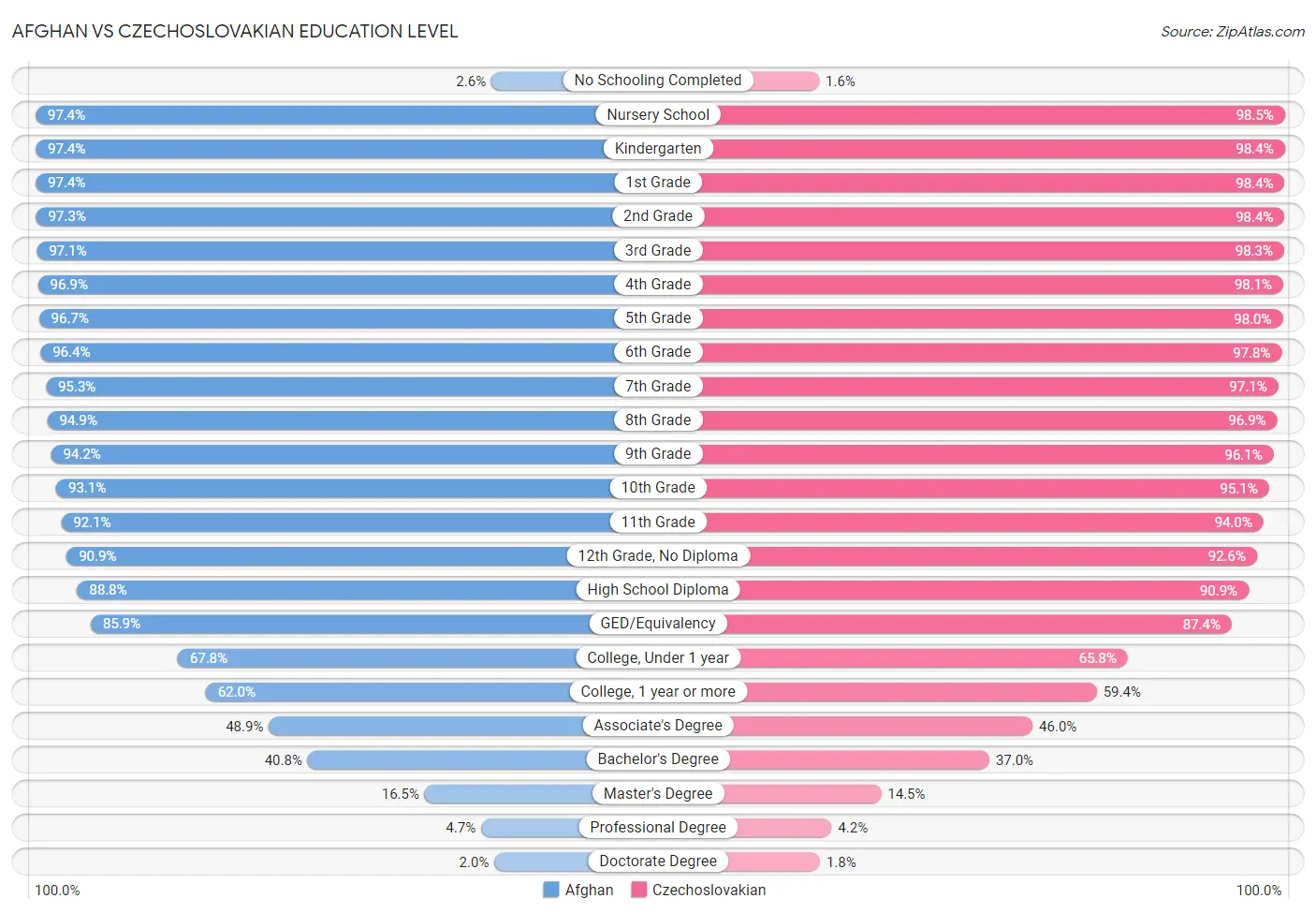
| Education Level Metric | Afghan | Czechoslovakian |
| No Schooling Completed | Tragic 2.6% | Exceptional 1.6% |
| Nursery School | Tragic 97.4% | Exceptional 98.5% |
| Kindergarten | Tragic 97.4% | Exceptional 98.4% |
| 1st Grade | Tragic 97.4% | Exceptional 98.4% |
| 2nd Grade | Tragic 97.3% | Exceptional 98.4% |
| 3rd Grade | Tragic 97.1% | Exceptional 98.3% |
| 4th Grade | Tragic 96.9% | Exceptional 98.1% |
| 5th Grade | Tragic 96.7% | Exceptional 98.0% |
| 6th Grade | Tragic 96.4% | Exceptional 97.8% |
| 7th Grade | Tragic 95.3% | Exceptional 97.1% |
| 8th Grade | Tragic 94.9% | Exceptional 96.9% |
| 9th Grade | Tragic 94.2% | Exceptional 96.1% |
| 10th Grade | Tragic 93.1% | Exceptional 95.1% |
| 11th Grade | Poor 92.1% | Exceptional 94.0% |
| 12th Grade, No Diploma | Fair 90.9% | Exceptional 92.6% |
| High School Diploma | Fair 88.8% | Exceptional 90.9% |
| GED/Equivalency | Average 85.9% | Exceptional 87.4% |
| College, Under 1 year | Exceptional 67.8% | Good 65.8% |
| College, 1 year or more | Exceptional 62.0% | Average 59.4% |
| Associate's Degree | Exceptional 48.9% | Average 46.0% |
| Bachelor's Degree | Exceptional 40.8% | Fair 37.0% |
| Master's Degree | Exceptional 16.5% | Fair 14.5% |
| Professional Degree | Excellent 4.7% | Fair 4.2% |
| Doctorate Degree | Excellent 2.0% | Fair 1.8% |
Afghan vs Czechoslovakian Disability
When considering disability, the most significant differences between Afghan and Czechoslovakian communities in the United States are seen in disability age under 5 (0.94% compared to 1.5%, a difference of 60.2%), hearing disability (2.7% compared to 3.6%, a difference of 29.9%), and disability age 18 to 34 (6.1% compared to 7.4%, a difference of 21.9%). Conversely, both communities are more comparable in terms of disability age 65 to 74 (22.6% compared to 23.0%, a difference of 1.6%), self-care disability (2.4% compared to 2.5%, a difference of 1.7%), and disability age over 75 (48.4% compared to 46.6%, a difference of 3.9%).
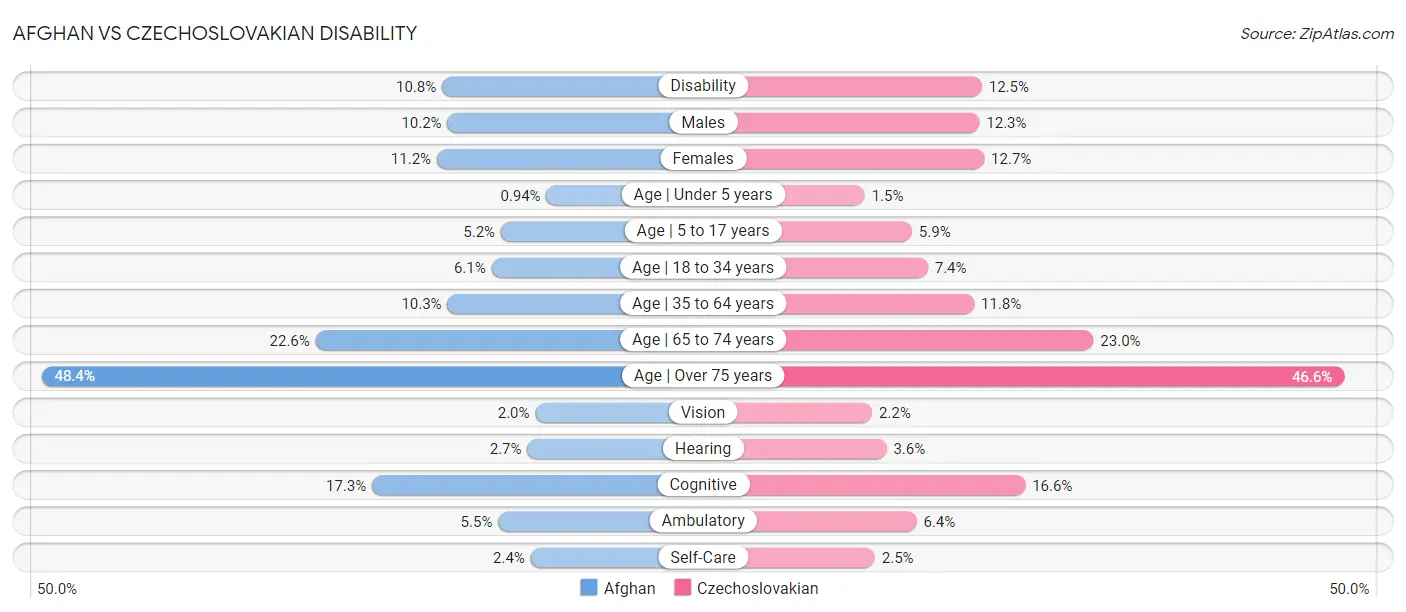
| Disability Metric | Afghan | Czechoslovakian |
| Disability | Exceptional 10.8% | Tragic 12.5% |
| Males | Exceptional 10.2% | Tragic 12.3% |
| Females | Exceptional 11.2% | Tragic 12.7% |
| Age | Under 5 years | Exceptional 0.94% | Tragic 1.5% |
| Age | 5 to 17 years | Exceptional 5.2% | Tragic 5.9% |
| Age | 18 to 34 years | Exceptional 6.1% | Tragic 7.4% |
| Age | 35 to 64 years | Exceptional 10.3% | Tragic 11.8% |
| Age | 65 to 74 years | Excellent 22.6% | Good 23.0% |
| Age | Over 75 years | Tragic 48.4% | Exceptional 46.6% |
| Vision | Exceptional 2.0% | Fair 2.2% |
| Hearing | Exceptional 2.7% | Tragic 3.6% |
| Cognitive | Fair 17.3% | Exceptional 16.6% |
| Ambulatory | Exceptional 5.5% | Tragic 6.4% |
| Self-Care | Excellent 2.4% | Average 2.5% |